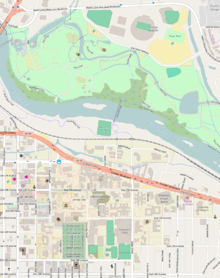University of Oregon Museum of Natural and Cultural History
 |
|
| Location | 1680 East 15th Eugene, Oregon |
|---|---|
| Type | History museum |
The University of Oregon Museum of Natural and Cultural History, commonly known as the UO Natural History Museum, is an American natural history museum at the University of Oregon in Eugene. Located near Hayward Field on the east side of the UO campus, it is the largest natural history museum between Seattle and San Francisco and a center for archaeological and paleontological research in the Pacific Northwest and the wider world. The museum headquarters and public spaces are located at 1680 East 15th Avenue in a building inspired by the design of Pacific Northwest Native longhouses.
The museum traces its origins to the creation of the University of Oregon in 1876, when state geologist Thomas Condon was hired as one of the first three UO professors, bringing his extensive fossil collection with him. The Oregon State Legislative Assembly created the Oregon State Museum of Anthropology (OSMA) at the UO in 1935, under the direction of archaeologist Luther Cressman. In 1936, the Condon Museum and State Museum of Anthropology were folded into the newly created UO Museum of Natural History, also directed by Luther Cressman. Since Cressman retired in the 1960s, the museum has had a series of distinguished directors, including J. Arnold Shotwell, Alice Parman, Don Dumond, C. Melvin Aikens, and now Jon Erlandson.
Today the museum has four divisions: the Condon Paleontological Collection; an Archaeological Research Division (a.k.a. OSMA), an Anthropological Collections division, and a Public Programs Division. The museum's collections include: nearly 100,000 fossils from Oregon, the Pacific Northwest, and around the world; nearly a million archaeological artifacts, including the famous Fort Rock sandals. that are among the oldest shoes in the world (~10,000 years old); extensive ethnographic collections from cultures worldwide, including over 1500 Native American baskets; and thousands of comparative specimens from modern or historical birds (and their eggs and nests), mammals, reptiles, marine and freshwater shells, and other organisms. The museum displays many of these artifacts, fossils, and objects in its exhibit halls, along with revolving exhibits highlighting the work of Pacific Northwest artists and other cultural and natural history themes. Surrounding the museum is a Native plant garden, a geological time line, and a replica of the Willamette Meteorite. The museum's new website also includes over 20 web galleries featuring objects from its collections.
...
Wikipedia

